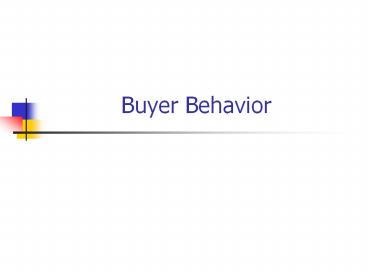Buyer Behavior PowerPoint PPT Presentation
1 / 33
Title: Buyer Behavior
1
Buyer Behavior
2
Model of Buyer Behavior (Fig. 5.1)
Marketing and Other Stimuli Marketing Product Pr
ice Place Promotion Other Economic Technological P
olitical Cultural
Buyers Black Box Buyer Characteristics Buyer
Decision Process
Buyer Responses Product Choice Brand
Choice Dealer Choice Purchase Timing Purchase
Amount
3
Approaches to Study of Buyer Behavior
- Economic model
- Learning theory model
- Psycho-analytic model
- Information processing model
4
The EBM model of buyer behavior (Engel,
Blackwell, and Miniard)
5
(No Transcript)
6
Factors Affecting Consumer Behavior Culture
- Culture is the Most Basic Cause of a Person's
Wants and Behavior.
- Subculture
- Group of people with shared value systems based
on common life experiences. - Hispanic Consumers
- African American Consumers
- Asian American Consumers
- Mature Consumers
7
Factors Affecting Consumer Behavior Culture
- Culture is the Set of Values, Perceptions, Wants
Behavior Learned by a Member of Society from
Family.
- Social Class
- Societys relatively permanent ordered
divisions whose members share similar values,
interests, and behaviors. - Measured by Occupation, Income, Education,
Wealth and Other Variables.
8
Factors Affecting Consumer Behavior Social
- Groups
- Membership
- Reference
- Family (most important)
- Husband, wife, kids
- Influencer, buyer, user
Social Factors
Roles and Status
9
Factors Affecting Consumer Behavior Personal
10
SRI Values and Lifestyles (VALS) (Fig. 5.3)
Actualizers
High Resources
High Innovation
Achievers
Fulfilleds
Experiencers
Makers
Strivers
Believers
Strugglers
Low Resources
Low Innovation
11
Factors Affecting Consumer Behavior Psychological
Motivation
Psychological Factors Affecting Buyers Choices
Beliefs and Attitudes
Perception
Learning
12
Maslows Hierarchy of Needs (Fig. 5.4)
13
Consumer Evaluation
- What criteria do consumers use to make
evaluations? What do consumers care about? - Values
- Benefits
- Attributes
- Means-End Value Chains
14
Means-End Value Chains
15
Multi-attribute evaluation
- Belief x Importance Model
- Evaluation is reflected by brand attitude
- Attitude is the sum of salient beliefs,
- Weighted by the importance of each belief
- Atto S(Bi x Ii) Summed for each attribute i.
- The Bi component indicates the strength of the
association. - The Ii component indicates the importance of that
association to brand attitude.
16
Buyer Decision Process (Fig. 5.6)
Purchase Decision
Postpurchase Behavior
Evaluation of Alternatives
Information Search
Need Recognition
17
Buyer Decision ProcessStep 1. Need Recognition
Buyer Recognizes a Problem or a
Need.
Needs Arising From Internal Stimuli
Hunger External Stimuli- Friends
State Where the Buyers Needs are Fulfilled and
the Buyer is Satisfied.
18
The Buyer Decision ProcessStep 2. Information
Search
Personal Sources
Commercial Sources
Public Sources
- Family, friends, neighbors
- Most effective source of
- information
- Advertising, salespeople
- Receives most information from
- these sources
Experiential Sources
- Mass Media
- Consumer-rating groups
- Handling the product
- Examining the product
- Using the product
19
The Buyer Decision ProcessStep 4. Evaluation of
Alternatives
Consumer May Use Careful Calculations Logical
Thinking
Consumers May Buy on Impulse and Rely on
Intuition
Consumers May Make Buying Decisions on Their Own.
Consumers May Make Buying Decisions Only After
Consulting Others.
Marketers Must Study Buyers to Find Out How They
Evaluate Brand Alternatives
20
The Buyer Decision ProcessStep 5. Purchase
Decision
- Purchase Intention
- Desire to buy the most preferred brand
- Purchase Decision
21
The Buyer Decision ProcessStep 6. Postpurchase
Behavior
Satisfied Customer!
- Consumers
- Expectations of Products Performance.
- Products Perceived
- Performance.
Dissatisfied Customer
22
Role of Consumer Involvement
- Sometimes consumers make evaluations/choices very
carefully - Sometimes consumers make evaluations/choices with
little care - Involvementstrength of motivation, importance
- High involvementB X I model
23
Low involvement evaluations
- Cognitive shortcuts (heuristics)
- Habit
- Affective responses
24
Stages in the Adoption Process
Awareness Consumer is aware of product, but
lacks information.
Interest Consumer seeks Information about new
product.
Evaluation Consumer considers trying new product.
25
Adopter Categories (Fig. 5.7)
Early Majority
Late Majority
Early Adopters
Innovators
Percentage of Adopters
Laggards
34
34
16
13.5
Time of Adoption
2.5
Late
Early
26
Influence of Product Characteristics on Rate of
Adoption
Relative Advantage Is the innovation superior
to existing products?
Communicability Can results be easily observed
or described to others?
Divisibility Can the innovation be used on a
trial basis?
Compatibility Does the innovation fit the
values and experience of the target market?
Complexity Is the innovation difficult
to understand or use?
27
What is a Business Market?
- A business market comprises all the organizations
that buy goods and services for use in the
production of other products and services that
are sold, rented, or supplied to others. - The business market is huge and involves many
more dollars and goods than do consumer markets.
28
Characteristics of Business Markets
Contain fewer, but larger buyers
Customers are more geographically concentrated
Buyer demand is derived from final consumer
demand
Marketing Structure and Demand
29
Characteristics of Business Markets
- Nature of the Buying Unit
- Business purchases involve more buyers.
- Business buying involves a more professional
purchasing effort.
30
Characteristics of Business Markets
Types of Decisions and the Decision Process
Build Long-Term Partnerships
31
Model of Business Buyer Behavior (Fig. 6.1)
Buyer Responses Product or service
choice Supplier Choice Order Quantities Deliver
y terms and times Service terms Payment
- The Environment
- Marketing
- Stimuli
- Product
- Price
- Place
- Promotion
- Other Stimuli
- Economic
- Technological
- Political
- Cultural
- Competitive
The Buying Organization The buying
center Buying decision process (Interpersonal
and individual influences) (Organizational
Influences)
32
Organizational Buying
- Professional purchasing
- Fewer buyers
- Larger purchases
- Closer, longer relationships/ reciprocity
- Geographic concentration
- Derived demand
- Lower price sensitivity
- Buying center
33
Participants in the Business Buying Process
Unexpected Situational Factors
Users
Ethical
Influencers
Decision-Making Unit of a Buying Organization is
Called Its Buying Center.
Buyers
Attitudes of Others
Deciders
Gatekeepers

